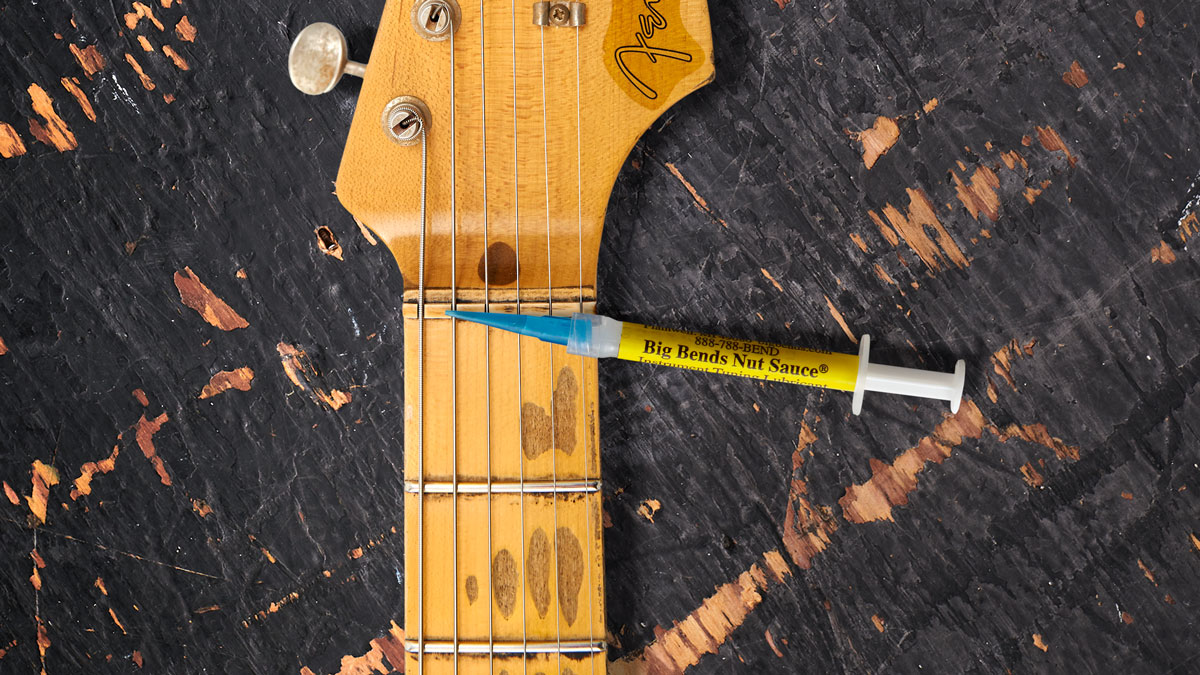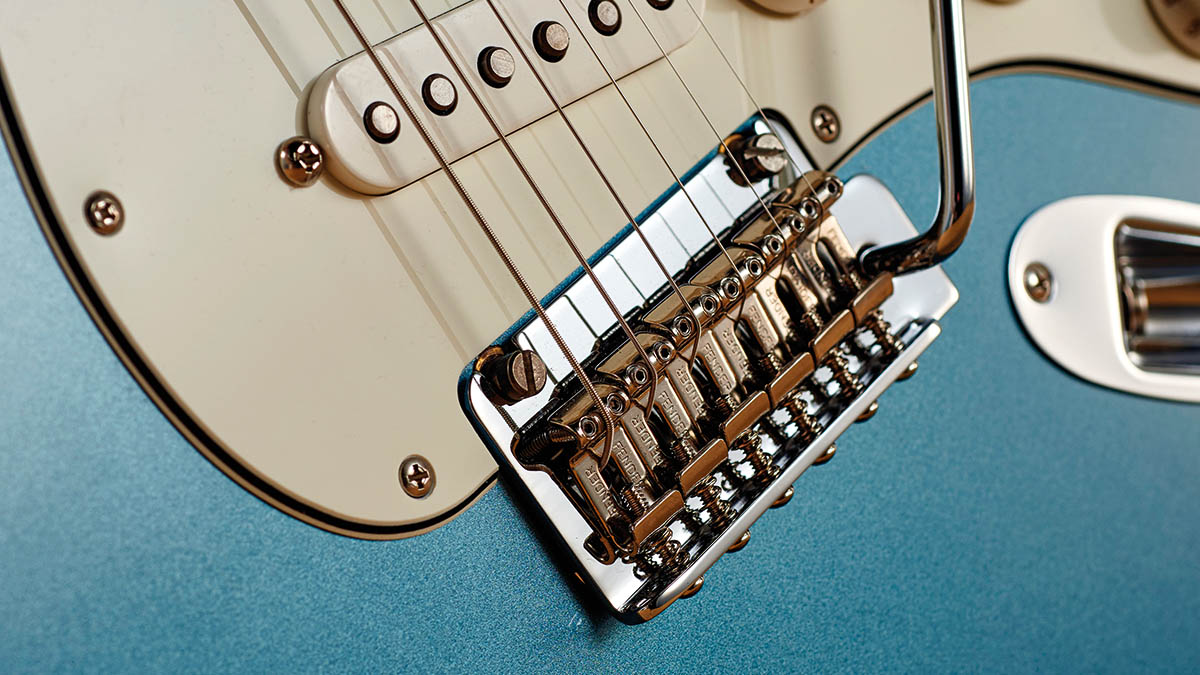
From subtle upgrades to SuperStrats and full-on Frankenstrats, Fender’s finest has always been the ideal candidate for guitar modding.
Here, we offer up 15 tone and maintenance tips to make your Stratocaster better than ever.
1. Dan Armstrong wiring

If you need a ‘Swiss Army knife’ guitar, but you don’t want to rout your Strat for humbuckers or drill holes in your pickguard, check out Dan Armstrong’s wiring mod. It connects all three pickups to the neck tone control to free up the middle tone control, which then becomes a parallel/series fader.
In short, with the control at 10, you have five regular SSS combinations. Set to 1, you get a HSH configuration, with the neck and bridge pickups operating in series with the middle pickup for pseudo humbucker tones.
2. Inductance Plating

If you crave a bit more beef and output from your bridge pickup, try installing a steel inductance plate. Various pickup makers can supply them or fit one for you. Minimal soldering is required and it’s a completely reversible modification.
Some players like the effect so much, they use inductance plates under their middle and neck pickups, too.
3. Blocking off

To disable a vibrato, loosen the strings and tighten the spring claw screws until the front of the plate touches the body. Take a piece of wood just wide enough to tap in between the block and the rear of the vibrato rout.
All the latest guitar news, interviews, lessons, reviews, deals and more, direct to your inbox!
Loosen the spring claw screws slightly to wedge it in place, reset the action and intonation and you’re done. Before replacing the spring cover, listen to your guitar because some believe Strats sound better without them.
4. Bridge Tone

Stratocaster bridge pickups tend to sound disproportionately bright because they don’t bleed treble through a tone control. Before investing in a ‘balanced’ set of replacement pickups, try swapping the middle pickup’s tone control to the bridge pickup or placing a jumper wire on the switch so the bridge and middle pickups share the same tone control. Or the neck and middle can share, it’s up to you.
5. Curing Strat-itus
Ever notice how the low E string sounds honky and out of tune as you play higher up the neck? Dubbed ‘Strat-itus’, it’s caused by the magnetic pull of the pickups inhibiting string vibration because they’re set too close to the strings.
The only cure is to back them off until the effect becomes acceptable or disappears completely, and it’s also why pro luthiers often lower the pickups when setting intonation.
6. Vibrato tuning

Everyone has their own preferences for vibrato setups, from blocked off to down only or fully floating. If you like to pull up as well as dive down, you can follow Carl Verheyen’s advice and balance the string and spring tension so the G string pulls up a minor 3rd and the B and top E by a semitone. It makes chord shimmers sound very musical and, with a bit of to-and-fro, it’s easy enough to dial in.
7. Swinging arms
Vibrato arms can loosen up with use, which makes them feel less responsive and accurate. To tighten them up, try wrapping some PTFE tape around the threaded end.
You can find it in the plumbing section of DIY stores. Alternatively, if you drop a small spring into the vibrato block it will press up against the arm and make it feel tighter and more stable.
8. Push-push switching

Unlike knurled Tele knobs, tapered Strat knobs are harder to grip and this makes push-pull switches harder to use. Instead, consider push-push switches because you only need to tap the top of the knob to make it pop up or press down. They’re ideal for installing custom wiring by stealth, with no need to rout the body or drill the pickguard for toggle switches.
9. Memphis wiring

This early Stratocaster wiring mod became popular with Strat players who also wanted a Telecaster-style in-between tone. The middle pickup is disconnected from the switch and main volume control, and the three-way switch combines with the volume and tone controls to operate just like a Telecaster.
The second tone control becomes the middle volume control so you still have all the regular Strat settings, plus all three pickups in parallel. It’s called ‘Memphis Wiring’ because it was preferred by Sun Records legend Roland Janes.
10. Sticking points

The main difference between Strats that hold tuning and those that don’t is friction, and the nut is usually to blame. A bit of lubrication in the nut slots can keep things running smoothly. Try using graphite from a soft pencil, Chapstick or a tiny dab of silicon grease, or specialist products such as Big Bends Nut Sauce and Music Nomad Tune-It.
While you’re at it, try a dab or two under the string tree and on the saddles. Also consider Wudtone’s subtly re-engineered vibrato assemblies and bridge plates for friction-free vibrato and enhanced response.
11. Stringing down

Fender’s neck design provides relatively little break angle over the nut, which is why one or two string trees are needed to sharpen the angle and eliminate string vibration behind the nut. Since non-roller string trees can be friction points, the alternative is to modify your stringing technique.
Rather than cut the strings short, leave sufficient length to wrap the D and G strings around the tuner posts several times so the string takes off from the very bottom of the post.
12. Joint ventures
Fender-style necks can be loose in the pocket. Sometimes it’s because the pocket is too large and you can pack the gaps with veneer strips to reduce the wiggle room. Screws sometimes work loose and luthiers can plug the screw holes with dowel then re-tap.
For a more permanent solution, consider having threaded inserts installed in the heel. E-Z Lok inserts are a popular choice and a firm fixing improves tone transfer and tuning stability.
13. Pickup upgrades
Upgrading pickups can be the biggest bang for your buck… and the biggest waste of money. It’s about making informed choices. Research the pickup specs of your favourite players and decide if you want Formvar or plain enamel wire, which grade of magnet you might prefer, and whether you need flat or staggered slugs.
You can go vintage-correct or choose stacked humbuckers for noiseless single-coil tone. Or what about dropping in P-90, Gold Foil, lipstick or humbucker soundalikes? The options are endless.
14. Buzz off
Stratocaster single coil pickups will buzz and hum depending on the environment, but there are ways to quiet things down. A RWRP (reverse wire/reverse polarity) pickup in the middle position will hum-cancel but only in positions 2 and 4.
Pickup and control cavities can be lined with adhesive-backed copper foil, and some players install dummy coils. But installing noiseless pickups is the only method guaranteed to silence a Strat completely.
15. Saddle up

You can swap Strat saddles to improve tuning stability or enhance tone, and there is no shortage of choice. In addition to vintage-style saddles, you could consider stainless steel, Tusq, brass or titanium.
To minimise friction, there are roller saddles, and Graph Tech offers a String Saver saddle to prevent breakages, as well as piezo-equipped Ghost saddles for acoustic tones at the flick of a switch.
Huw started out in recording studios, working as a sound engineer and producer for David Bowie, Primal Scream, Ian Dury, Fad Gadget, My Bloody Valentine, Cardinal Black and many others. His book, Recording Guitar & Bass, was published in 2002 and a freelance career in journalism soon followed. He has written reviews, interviews, workshop and technical articles for Guitarist, Guitar Magazine, Guitar Player, Acoustic Magazine, Guitar Buyer and Music Tech. He has also contributed to several books, including The Tube Amp Book by Aspen Pittman. Huw builds and maintains guitars and amplifiers for clients, and specializes in vintage restoration. He provides consultancy services for equipment manufacturers and can, occasionally, be lured back into the studio.

